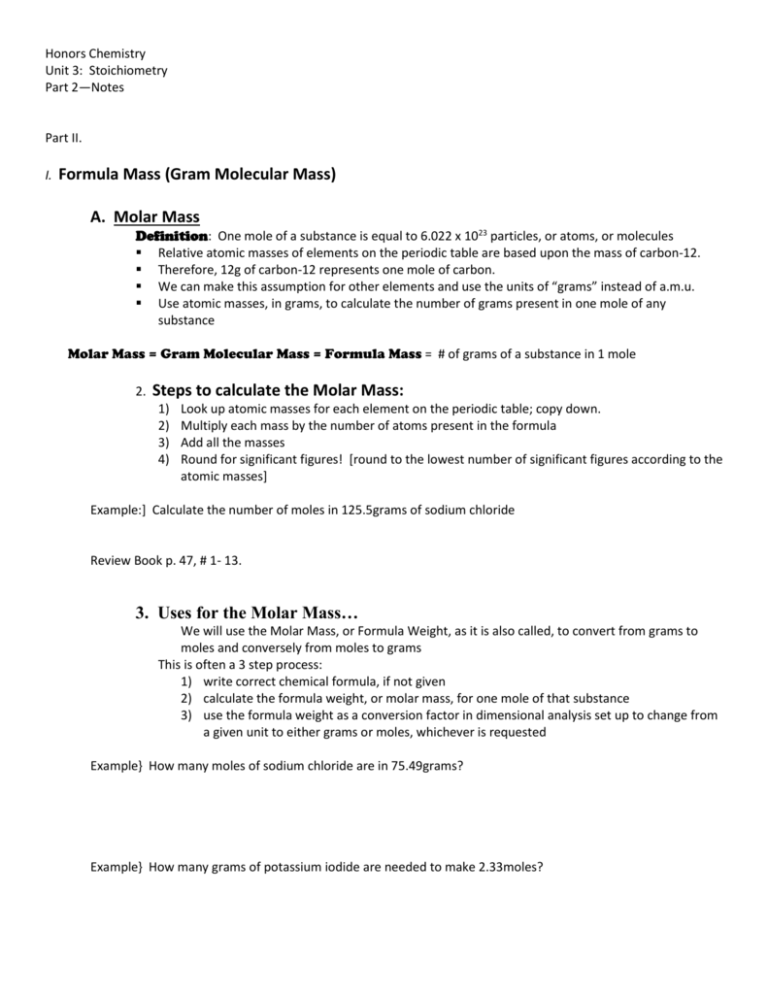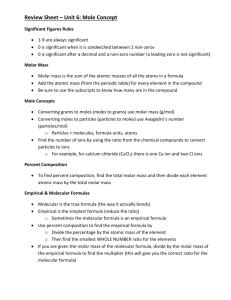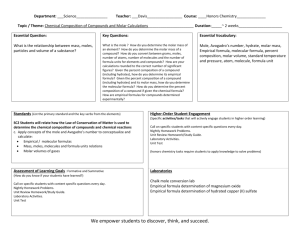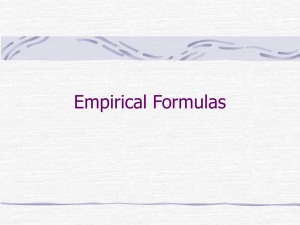Part 2—Notes
advertisement

Honors Chemistry Unit 3: Stoichiometry Part 2—Notes Part II. I. Formula Mass (Gram Molecular Mass) A. Molar Mass Definition: One mole of a substance is equal to 6.022 x 1023 particles, or atoms, or molecules Relative atomic masses of elements on the periodic table are based upon the mass of carbon-12. Therefore, 12g of carbon-12 represents one mole of carbon. We can make this assumption for other elements and use the units of “grams” instead of a.m.u. Use atomic masses, in grams, to calculate the number of grams present in one mole of any substance Molar Mass = Gram Molecular Mass = Formula Mass = # of grams of a substance in 1 mole 2. Steps to calculate the Molar Mass: 1) 2) 3) 4) Look up atomic masses for each element on the periodic table; copy down. Multiply each mass by the number of atoms present in the formula Add all the masses Round for significant figures! [round to the lowest number of significant figures according to the atomic masses] Example:] Calculate the number of moles in 125.5grams of sodium chloride Review Book p. 47, # 1- 13. 3. Uses for the Molar Mass… We will use the Molar Mass, or Formula Weight, as it is also called, to convert from grams to moles and conversely from moles to grams This is often a 3 step process: 1) write correct chemical formula, if not given 2) calculate the formula weight, or molar mass, for one mole of that substance 3) use the formula weight as a conversion factor in dimensional analysis set up to change from a given unit to either grams or moles, whichever is requested Example} How many moles of sodium chloride are in 75.49grams? Example} How many grams of potassium iodide are needed to make 2.33moles? B. Percent Composition The percent composition of each element within a compound can be calculated using the molecular mass and the mole ratios of the elements present. Even if not stated, assume that the percentages always add to 100! Use formula on Table T! Example] What is the percent hydrogen and percent oxygen in water? C. Hydrates Definition = hydrates are compounds that have a certain ratio of water molecules trapped within the solid, crystal structure The water may be physically removed by gentle heating This creates an “anhydrous salt”, an inorganic, or ionic, compound without any water attached o Written as: CuSO4 5H2O o Read as: “copper (II) sulfate penta hydrate”, because 5 water molecules are attached to each copper (II) sulfate molecule Can calculate the ratio of water molecules present in the formula by using a percent composition calculation with the mass of the hydrate and the mass of the anhydrous salt Example: a) What is the name of Mg(OH)2• 7H2O? b) Calculate the percentage of water present in one mole of the compound above. c) What mass of anhydrous salt should remain if 5.00g of the hydrate are heated to constant mass? D. Moles and Molecules Can easily convert from moles to grams, or moles to molecules or atoms by using conversion factors LITERS x 22.4 for gases at STP MOLES F.W. x 6.022x1023 x GRAMS MOLECULES X ATOMS # atoms per molecule Examples using the conversion chart: A] convert 75.4grams of neon gas to liters, at STP. B] convert 58.2grams of sodium hydroxide into molecules. C] how many atoms are in 3.29moles of carbon dioxide. D] How many molecules are in 275.3grams of potassium chloride. E] how many atoms are present in 139.2grams ammonium nitrate? F] How many atoms are present in 1.95grams of nitrogen gas? II. Empirical and Molecular Formulas Definitions Molecule = two or more nonmetals only bonded together Compound = two or more atoms bonded together; metals or polyatomics may be involved! Empirical formula = formula of a compound with the smallest whole, number ratios of the atoms Molecular formula = the actual ratio of atoms bonded together in a compound; could be Reduced; numerical multiple of the empirical formula Using molecular and empirical formulas The ratio of the molar mass and the ratios of elements are proportional! Scenario #1: Categorize the formulas as empirical or molecular. Then be able to find the empirical formula if the molecular is given. Examples] what is the empirical formula if the molecular is C6H12O6? How do the formula weights of each compare? Scenario #2: Given an empirical formula and the molar mass of the molecular formula, the actual molecular formula can be calculated. Find the molecular mass of the empirical formula and divide this into the molar mass of the molecular formula to find the multiplier Example] the empirical formula is CH2. If the formula weight of molecular formula (the multiple) is 42g/mol, what is the molecular formula? Scenario #3: Find the Empirical formula, and possibly the molecular formula too, by starting with the percent composition of element Steps: 1) 2) 3) 4) 5) 6) 7) 8) 9) Convert percent given to grams [assume 100 gram sample] Convert grams to moles using atomic mass Divide by the smallest number of moles Compare mole values for each element. Need all whole numbers! If necessary, multiple all mole values by a number to generate all whole numbers [if ratio is 1.5 : 2, multiply by 2 to give 3 : 4 ratio] Write the empirical formula! Calculate the formula weight of the empirical formula. Divide empirical formula weight into the molecular formula weight to get the ratio. Multiple mole values by the ratio to obtain molecular formula! Example] Calculate the empirical formula given 89% oxygen and 11% hydrogen III. Calculations with Equations Equations are balanced using MOLE ratios! Therefore, we can use molar masses and balanced equations to calculate the mass of a given substance on one side of the equation using the initial mass of a substance on the other side of the equation. This system allow us to predict the yield for a chemical reaction, as well as predicting the necessary masses of the reactants that create this amount of a product. DIMENSIONAL ANALYSIS is often used as a tool for these conversions. As a Reminder… Keys to successful Dimensional Analysis conversions: 1) Determine the quantity and unit given in the problem 2) Determine the proper conversion factors needed to change the unit from what is given to the unit that is requested 3) Set the given number and unit over “1” to begin. 4) Place the same unit in the bottom of the first parenthesis. 5) Use the new unit from the conversion factor in the top of the parenthesis. 6) Place the values next to their corresponding units. 7) If more conversions are necessary to get to the desired endpoint, then repeat this process, steps #4-6, until the proper unit is on the top of the last parenthesis. 8) Perform the math to generate a value with the new unit. 9) Write the final number with the new unit at the end. 10) Round for significant digits! [Look back at the original value, given in the problem!!] Examples: Calculate the amount of NaCl produced when 184.9g sodium metal reacts with excess chlorine gas to form sodium chloride. Equation for this reaction:_____________________________________________________________(balanced) Molar masses needed: Pathway from start to finish:__________________________________________________________________ Work to calculate answer:








